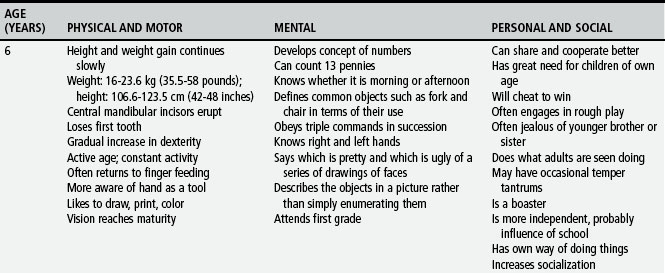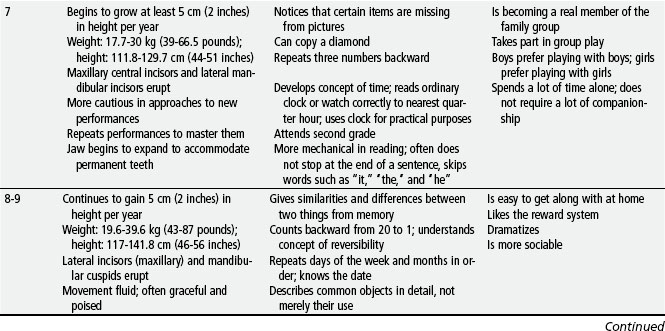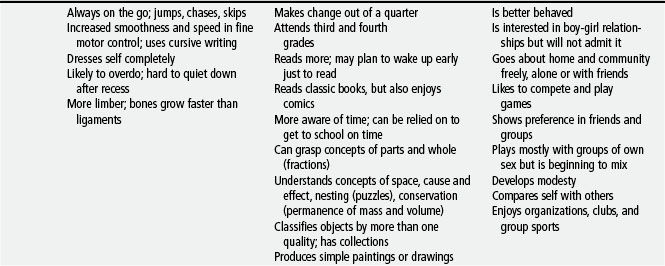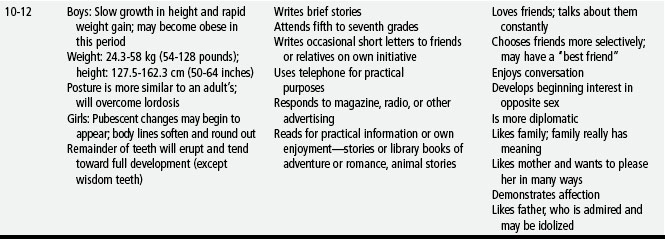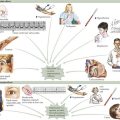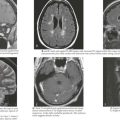Part 1 History and Physical Assessment
HEALTH HISTORY
Information
Present Illness (PI)
Past history (PH)
To elicit a profile of the individual’s previous illnesses, injuries, or operations
REVIEW OF SYSTEMS
General—Overall state of health, fatigue, recent and/or unexplained weight gain or loss (period of time for either), contributing factors (change of diet, illness, altered appetite), exercise tolerance, fevers (time of day), chills, night sweats (unrelated to climatic conditions), frequent infections, general ability to carry out activities of daily living, behavior
Head—Headaches, dizziness, injury (specific details)
Cardiovascular—Cyanosis or fatigue on exertion, cold extremities, history of heart murmur or rheumatic fever, anemia, date of last blood count, blood type, recent transfusion
SUMMARY OF PHYSICAL ASSESSMENT OF THE NEWBORN
PHYSICAL ASSESSMENT SUMMARY
TABLE 1-3 General Trends in Height and Weight Gain During Childhood
| AGE GROUP | WEIGHT | HEIGHT |
|---|---|---|
| Birth-6 months |
Ask cooperative child to open mouth wide and say “Ahh”; usually not necessary to use tongue blade.
22. Neurologic assessment (see Table 1-2)
| Tachypnea | Increased rate |
| Bradypnea | Decreased rate |
| Dyspnea | Distress during breathing |
| Apnea | Cessation of breathing |
| Hyperpnea | Increased depth |
| Hypoventilation | Decreased depth (shallow) and irregular rhythm |
| Hyperventilation | Increased rate and depth |
| Kussmaul respiration | Deep and labored respiration, usually seen in respiratory acidosis (e.g., diabetic ketoacidosis) |
| Cheyne-Stokes respiration | Gradually increasing rate and depth with periods of apnea |
| Biot respiration | Periods of hyperpnea alternating with apnea (similar to Cheyne-Stokes except that the depth remains constant) |
| Seesaw (paradoxic) respiration | Chest falls on inspiration and rises on expiration |
| Agonal respiration | Last gasping breaths before death |
TABLE 1-2 Assessment of Cranial Nerves
| CRANIAL NERVE | DISTRIBUTION/FUNCTION | TEST |
|---|---|---|
| I—Olfactory (S)* | Olfactory mucosa of nasal cavity | With eyes closed, have child identify odors such as coffee, alcohol, or other smells from a swab; test each nostril separately. |
| II—Optic (S) | Rods and cones of retina, optic nerve | Check for perception of light, visual acuity, peripheral vision, color vision, and normal optic disc. |
| III—Oculomotor (M)* |
TABLE 1-4 Motor Development During Infancy
| AGE (MONTHS) | GROSS MOTOR | FINE MOTOR |
|---|---|---|
| 1 | ||
| 2 | ||
| 3 | ||
| 4 | ||
| 5 | ||
| 6 | ||
| 7 | ||
| 8 | ||
| 9 | ||
| 10 | ||
| 11 | ||
| 12 |
* Milestones that represent essential integrative aspects of development that lay the foundation for the achievement of more advanced skills
TABLE 1-5 Motor Development During Toddler Years
| AGE (MONTHS) | GROSS MOTOR | FINE MOTOR |
|---|---|---|
| 15 | ||
| 18 | ||
| 24 | ||
| 30 |
| Motor Development: Preschool Years | ||
|---|---|---|
| AGE (YEARS) | GROSS MOTOR | FINE MOTOR |
| 3 | ||
| 4 | ||
| 5 | ||
| Grade 0 | 0 | Absent |
| Grade 1 | + | Diminished |
| Grade 2 | ++ | Normal, average |
| Grade 3 | +++ | Brisker than normal |
| Grade 4 | ++++ | Hyperactiave (clonus) |

